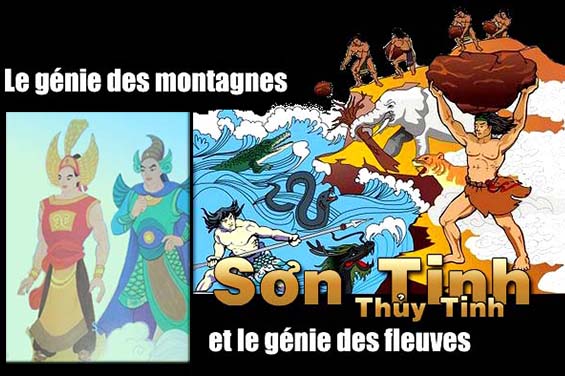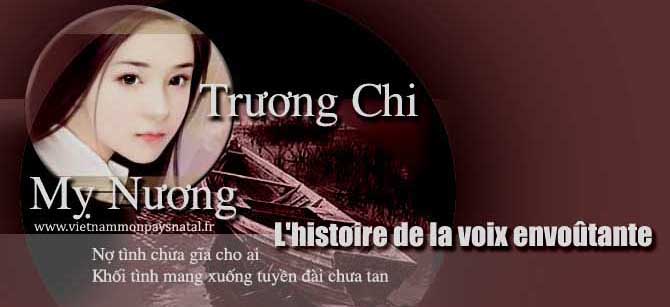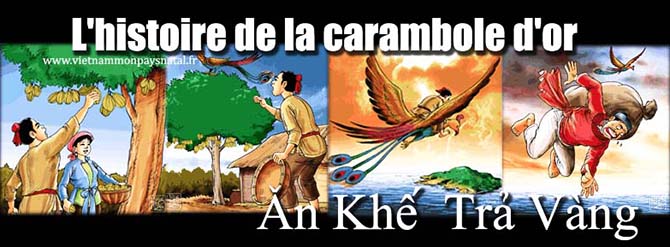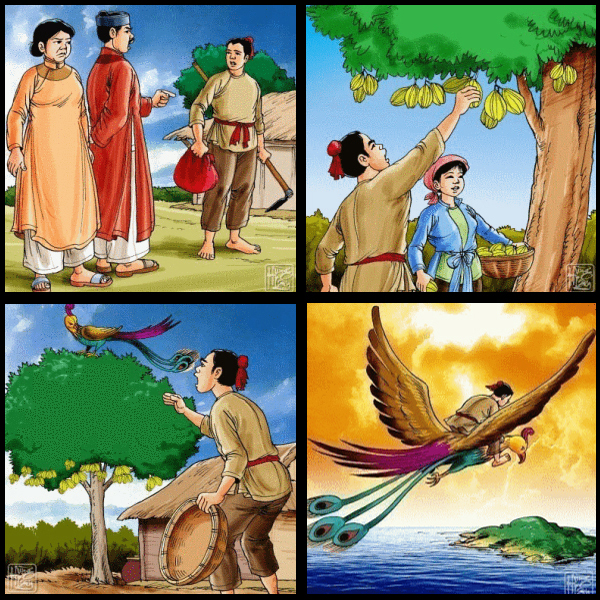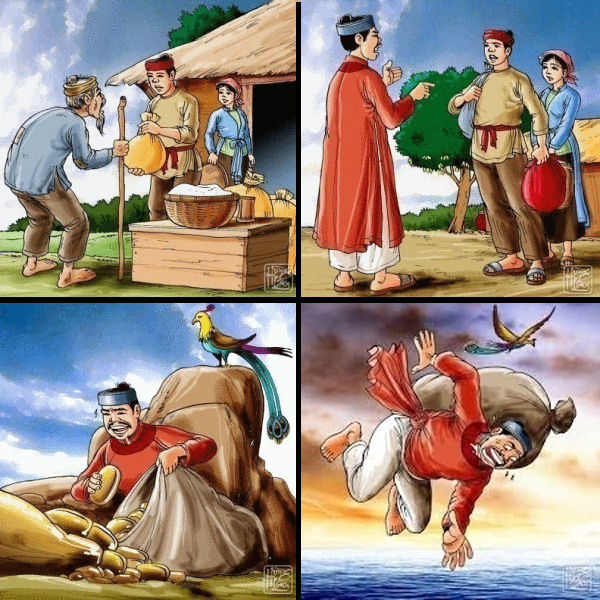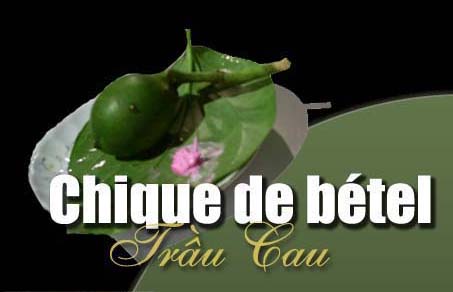
Version vietnamienne
La chique de bétel.
Jadis, sous le règne du roi Hùng IV, vivaient deux frères jumeaux, Cao Tân et Cao Lang (*). Ils se ressemblaient tellement qu’il était difficile de les distinguer. Leurs parents étaient décédés depuis longtemps. Ils suivaient les cours d’un vieux maître du village, Lưu Huyền ayant eu une fille unique de nom Liên dont la beauté recueillait tous les hommages de tous les jeunes de la région.
Le vieux maître se prit d’affection pour les deux. Il désira accorder la main de sa fille à l’un d’eux, de préférence l’aîné car selon la coutume vietnamienne, l’aîné se maria le premier. Pour arriver à les distinguer, il dut recourir à un petit subterfuge en les invitant à dîner chez lui. Le premier à prendre les baguettes était l’aîné. C’était ainsi que Cao Tân reçut la main de sa fille sans se douter que son cadet vouait aussi à cette dernière un ardent amour. Ils continuaient à vivre ensemble dans une harmonie complète et connaissaient un bonheur sans faille.
Cao Tân n’en continuait pas moins à aimer son cadet comme avant et faisait tout pour rendre ce dernier plus heureux. Mais celui-ci, malgré cela, n’arriva pas à refouler les peines de son cœur. Il décida de les quitter et trouva le soulagement dans l’aventure. Après tant de jours de marche, il finit par tomber d’épuisement sur la route et fut transformé en un bloc de calcaire d’un blanc immaculé.
Pris d’une inquiétude grandissante pour son frère, l’aîné partit à sa recherche. Il suivit le même chemin pris par son cadet. Un beau matin, après tant de jours de marche, il arriva près du bloc calcaire, s’y assit et succomba d’inanition. Il fut métamorphosé en un bel arbre (aréquier) haut avec des palmes vertes et des petits fruits oblongs. L’arbre commença à étendre sa ramure et son ombre au dessus du bloc calcaire pour le protéger contre les intempéries.
Restée sans nouvelles de son mari, la jeune femme Liên, quitta à son tour, la maison et se mit en quête de son époux. Elle parcourut des champs et des prairies, traversa des villages et arriva enfin un jour tout près de l’aréquier. Fatiguée par la marche, elle s’adossa au pied de l’arbre, mourut à son tour et fut changée en une plante dont les lianes s’enroulaient autour du tronc de l’arbre avec de larges feuilles d’un vert intense en forme de cœur.
Un jour, de passage dans ce coin, le roi Hùng apprit cette histoire. Il essaya de mâcher du bétel et d’arec avec un peu de la chaux du bloc calcaire. Il constata que la salive obtenue était vermeille comme le sang et avait une saveur à la fois fraîche, acidulée et odorante. Il ordonna désormais que le bétel et l’arec durent figurer au mariage comme une offrande rituelle. C’est l’une des coutumes vietnamiennes qu’il faut respecter lors de la fête de mariage. Il y a toujours des noix d’arec et des feuilles de bétel d’un vert intense en forme de cœur faisant partie des cadeaux de mariage et symbolisant le gage d’amour conjugal et la fidélité.
Semblable à une cigarette, la chique de bétel facilite le début de la conversation dans la société vietnamienne d’autrefois. C’est pourquoi on a l’habitude de dire en vietnamien « Miếng trầu là đầu câu chuyện ». La chique de bétel sert à mesurer aussi le temps car en l’absence d’horloge à cette époque, une bouchée de bétel correspond à peu près trois ou quatre minutes, ce qui permet d’avoir une idée sur la durée de la conversation.
La chique de bétel est une coutume très ancienne trouvée chez les populations vivant dans les régions s’étendant de l’Inde jusqu’au Japon méridional, recouvrant aussi l’Asie du Sud-Est et la Chine du Sud. Il paraît que la chique de bétel porte le même effet que le coca pour couper la faim. Malgré la disparition de cette coutume au fil des années, les feuilles de bétel et les noix d’arec continuent à rester une offrande cultuelle et être visible au moment des fiançailles et du mariage des Vietnamiens ou à l’occasion des Tết.
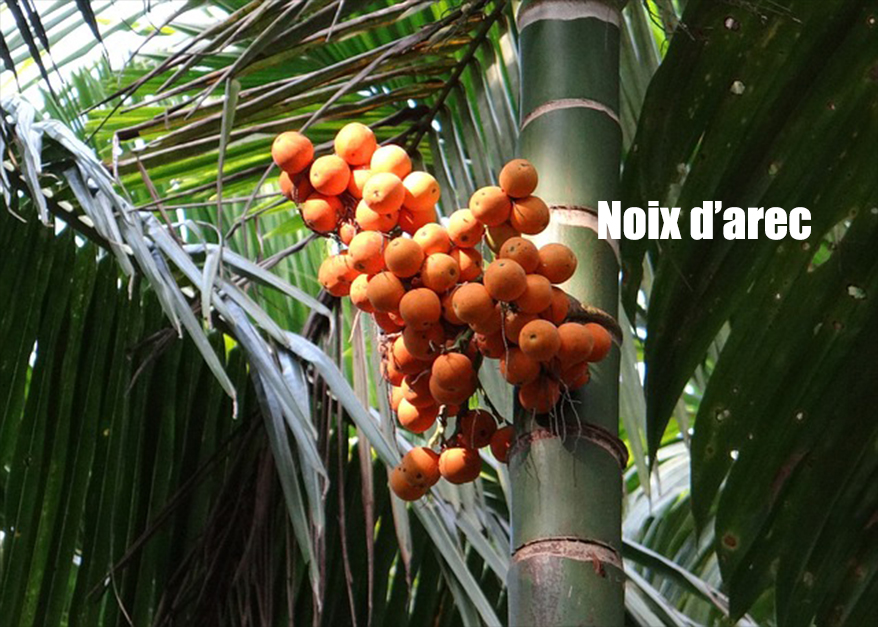
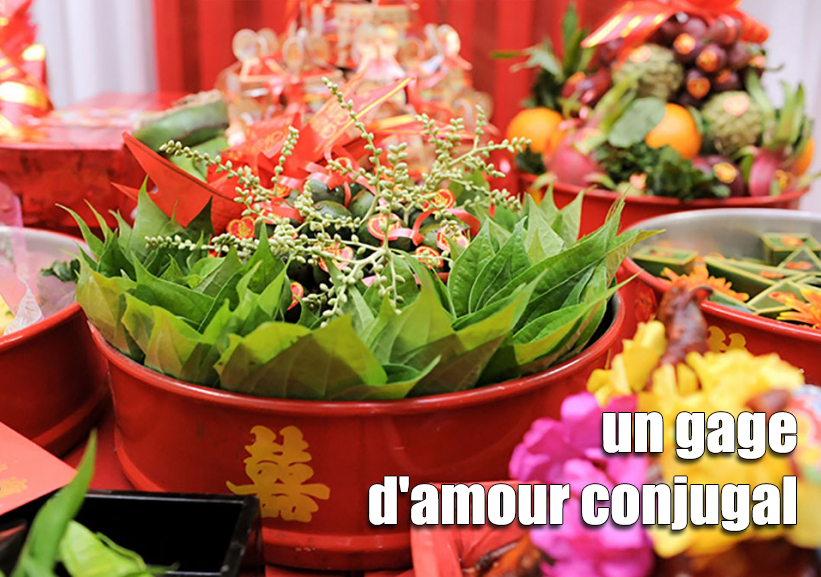
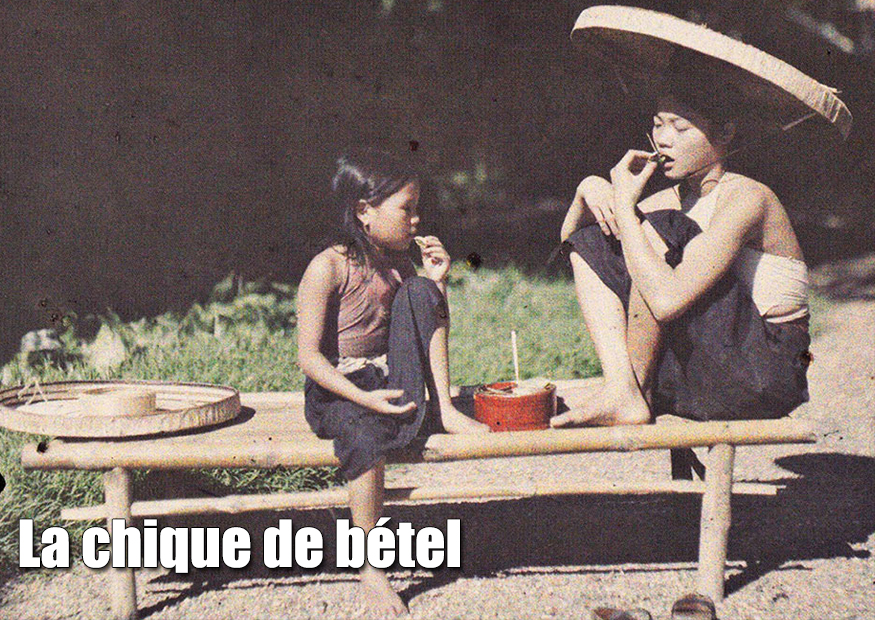
Chuyện trầu cau
Ngày xưa, dưới thời vua Hùng IV, có hai anh em sinh đôi là Cao Tân và Cao Lang.Hai anh em trông giống nhau như đúc khó mà phân biệt được. Cha mẹ đã qua đời từ lâu. Hai anh em đến học chung cùng một thầy giáo tên là Lưu Huyền. Ông nầy có một đứa con gái tên Liên duy nhất rất xinh đẹp được tất cả thanh niên trong vùng trầm trồ ngưỡng mộ.
Ông giáo làng nầy rất qúi cả hai anh em. Ông muốn gã đứa con gái của mình cho một trong hai người nầy, nhất là cho người anh cả, vì theo phong tục Việt Nam, người anh cả phải lấy vợ trước. Để có thể phân biệt được giữa họ, ông phải dùng đến một mẹo nhỏ bằng cách mời họ đến dùng cơm tối tại nhà. Người đầu tiên cầm đũa là người anh cả. Chính nhờ vậy mà Cao Tân được kết hôn với cô con gái nhưng không biết em trai của mình cũng yêu thầm cô con gái nầy. Họ tiếp tục sống chung với nhau rất hòa thuận và tận hưởng niềm hạnh phúc chung. Cao Tân vẫn tiếp tục yêu thương em trai của mình như trước và làm mọi thứ để người em được hạnh phúc hơn. Nhưng người em trai không thể kìm nén nỗi đau trong lòng nên quyết định ra đi và tìm nguồn an ủi trong cuộc phiêu lưu. Sau bao nhiêu ngày đi bộ, anh ta cuối cùng ngã bệnh mà chết vì kiệt sức trên đường và biến thành một khối đá vôi trắng tinh.
Càng lo lắng cho em trai mình, người anh cả lên đường đi tìm em. Anh đi theo con đường tương tự mà em trai của mình đã trải đi qua. Một buổi sáng đẹp trời, sau bao ngày đi bộ, anh ta đến nơi có khối đá vôi, ngồi tụt xuống đó rồi mõi mòn qua đời và được biến thành một cây cau xinh đẹp với những lá cọ xanh tươi và những quả nhỏ hình thuôn dài. Cây nầy bắt đầu vươn cành ra và tỏa bóng mát lên trên khối đá vôi xem như để bảo trợ nó chống lại những lúc có mưa gió.
Không có tin tức của chồng, Liên người phụ nữ trẻ lượt rời khỏi nhà và đi tìm chồng. Cô vượt qua những cánh đồng, những ngôi làng và cuối cùng có một ngày cô lại đến gần cây cau. Đi quá mệt mỏi, cô mới dựa lưng vào chân cây cau, lần lượt chết đi và được biến thành một loài thực vật có dây leo quấn quanh thân cây cau với những chiếc lá rộng màu xanh đậm hình trái tim.
Một hôm, khi đi ngang qua nơi nầy, vua Hùng mới biết được câu chuyện này. Ngài mới lấy trầu và cau đưa lên miệng nhai với một tí vôi từ khối đá nầy. Ngài nhận thấy nước bọt thu được có màu hồng như máu và có mùi vị thơm ngon. Bây giờ ngài mới ra lệnh rằng từ đây trầu cau phải được đưa vào hôn lễ như một lễ vật. Đó là một trong những phong tục mà người dân Việt cần phải tôn trọng trong tiệc cưới. Quà cưới luôn luôn phải có các quả cau với những chiếc lá trầu xanh nồng nàn hình trái tim. Trầu cau tượng trưng cho tình yêu thương vợ chồng và lòng chung thủy sắt son.
Tương tự như điếu thuốc lá, miếng trầu giúp ta dễ bắt nói chuyện hơn trong xã hội Việt Nam thưở xưa. Đây là lý do tại sao chúng ta thường nói trong tiếng Việt « Miếng trầu là đầu câu chuyện« . Ăn trầu được sử dụng để đo thời gian vì thời đó không có đồng hồ, một miếng trầu chỉ cần nhai khoảng ba hoặc bốn phút, điều này gíúp chúng ta biết khoảng thời gian của cuộc trò chuyện. Tục ăn trầu là một phong tục cổ xưa được tìm thấy trong các nhóm dân cư sống ở các khu vực trải dài từ Ấn Độ đến miền nam Nhật Bản, bao gồm luôn cả Đông Nam Á và miền Nam Trung Quốc. Có vẻ như miếng trầu có tác dụng tương tự như nước coca để ngăn cơn đói. Mặc dù phong tục này đã biến mất theo ngày tháng, các lá trầu và các quả cau vẫn tiếp tục là một lễ vật tín ngưỡng và thường trông thấy ở các lễ quan trọng như đính hôn, cưới hỏi hay các Tết lớn nhỏ của người Việt Nam.
(*) Hai chữ Tân và Lang ghép lại thì thành Tân Lang có nghĩa là cây cau. L’association des deux mots Tân et Lang désigne l’aréquier.

